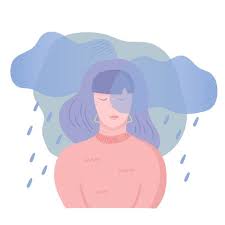Seasonal Depression Takes a Hold on Students

An image that depicts the emotion of sadness that may be felt by those experiencing SAD.
October 28, 2021
As autumn is approaching, and the weather turns to cold, many people are starting to feel down. Some common symptoms include a hard time waking up to start the day, extra fatigue, and general feelings of depression. This can be known as seasonal affective disorder (SAD) and it affects an estimated amount of 5% of the US population (American Family Physician [AFP]). In addition to this, it is estimated that another 10-20% of people may have mild SAD (North Point Hospital).
Some more facts about SAD is that it is most common in women over the age of 20. In fact, women are four times more likely to develop SAD than men are, making up around 70% of those who suffer. SAD can come into effect at any time of the year; however, it is most commonly seen as “the winter blues” (AFP).
This can be linked to serotonin levels changing with menopause/PMS or melatonin levels increasing when brains associate a lack of daylight with lack of sleep. The increase of melatonin often causes symptoms of depression. Many experts believe that a lack of sunlight is most often the cause of SAD. Another cause could be stress; when less sunlight causes exhaustion, things tend to pile up for people to do. This adds stressful situations that many are not able to cope with (National Institute of Mental Health [NIMH]). Additionally, for some people a change in time, also known as daylight savings, can change our internal rhythm and make us feel overall different than what we had been previously accustomed to. There are a wide variety of speculated causes for SAD and research can confirm or refute all of them.
Scientists have developed prescription medications that boost serotonin levels to lessen depressive symptoms. These medications can help people who are facing this temporary fog to be able to have a mood boost. Another common solution that works for some is light therapy. Going outside is proven to add natural light for the body in order to decrease or regulate the amount of melatonin that is produced in the brain. Fluorescent lights with high amounts of Lux, the units of measuring light flow, are also known to help with regulation of melatonin levels. These can be found in stores online and in places like offices. In addition to light exposure, regular exercise is shown to increase heart rate and endorphins in the body. This can cause an almost immediate mood boost for some. Finally, therapy is a great way to help reduce symptoms of depression or suggest better alternatives that are specific to each brain. When you have a proper therapist to help, it is much more support to know that there is somebody who understands what you are going through (NIMH).
Yorba Linda High School Psychologist, Desiree Parsons (Staff), gives advice and comments on the matter. “People who struggle with this or any mild to moderate depressive symptoms would always be well advised to focus on the 4 pillars of good health: exercise, nutrition, sleep and relaxation. So much of what we know about depression centers upon our body’s chemistry, and all 4 of these factors have a substantial impact on our physical well-being which then directly affects our mental health… A person who believes themselves to suffer from seasonal depressive disorder would be wise to prepare for the pending winter… [and] stockpile the positives. Beginning in the fall, start planning and executing activities that you enjoy, such as hangouts with friends, hobbies, outings, clubs and even community service are all great things to do to offset the ‘winter blues.’ … One of the benefits of living in Yorba Linda is that we are situated in sunshiny Southern California! Take advantage of all that beautiful sunshine; the natural vitamin D it produces in our bodies has a natural antidepressant effect.” She goes on to give a broader perspective towards mental health and says, “It is ok to feel sad sometimes, and we need to be ok to sit with those feelings and trust others to be there with us in those moments. One of the most amazing things about our human brain is our incredible range of emotion, and part of learning to cope is understanding that we can experience a wide variety of feelings without falling apart even if some emotions don’t particularly feel good… You are still in control, you direct your path and you don’t have to do what it says no matter how hard it tries to tell you otherwise. Sometimes though, for some of us, it really doesn’t feel that way at all. When the bad really starts to outweigh the good, that is when we need to seek help. We have resources here at school and online.”
Some mental health resources that are suggested on the Wellness section of the YLHS website include (ylhs.org):
Your Life, Your Voice:
If you are having thoughts of harming yourself or you are being abused, please call. These are serious issues that are best handled in one-on-one conversations with counselors. Always open, counselors ready for call 24/7
1-800-448-3000
The OC Warm Line:
Non-crisis, caring support for anyone struggling with emotional/mental health challenges.
(877) 910-WARM (877-910-9276)
Reach Out:
Information and support service for young adults facing tough times and struggling with mental health issues.
1 (800) 448-3000 | www.reachouthere.com
National Institute of Mental Health (NAMI):
Helpline and family resources and groups for those affected by mental illness.
1 (800) 950-NAMI (Helpline) | www.namioc.org
Didi Hirsch Mental Health Center:
Santa Ana Services: Crisis line, outreach and survivor support services for family members of a person who committed suicide.
(714) 547-0855 | www.didihirsch.org/orange-county





































Mrs Heim • Nov 2, 2021 at 10:36 AM
Excellent article! Thanks for this, and for improving mental health awareness, Karina! We are also very fortunate to have such a wonderful school psychologist here at YLHS, Mrs Parsons is amazing!